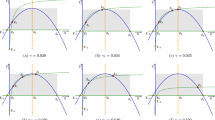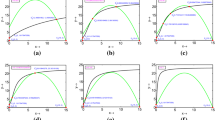Abstract
In this research paper, we delve into the critical examination of interactions between predators and prey within ecological systems. Drawing on principles from theoretical biology and mathematical ecology, our study introduces a predator-prey model that incorporates the Smith growth rate of prey and Holling type II functional response, while uniquely considering the influence of hunting cooperation between predators. We rigorously explore various aspects such as positivity, boundedness, local stability, and different bifurcation types, including transcritical, saddle-node, Hopf, cusp, and Bogdanov-Takens bifurcation. Both theoretical analyses and graphical representations are employed to offer a comprehensive understanding of the system dynamics. To unravel the complexity of the interactions, we present two-parametric bifurcation diagrams, utilizing a and K as bifurcation parameters. The first quadrant of the \(a-K\) plane is systematically partitioned into seven regions, demarcated by distinct bifurcation curves. Bistable dynamics are exhibited in the ecological system. A notable observation stemming from our investigation is the vulnerability of the predator population to extinction at low carrying capacity values. Furthermore, our numerical findings underscore the enhanced stability of the system with an increase in hunting cooperation. This research contributes valuable insights into the intricate dynamics of predator-prey interactions, shedding light on the significance of ecological parameters and cooperative behaviors in shaping the stability and persistence of these systems.






Similar content being viewed by others
Data Availability
No datasets were generated or analysed during the current study.
References
R.M. Pringle, T.R. Kartzinel, T.M. Palmer, T.J. Thurman, K. Fox-Dobbs, C.C. Xu, M.C. Hutchinson, T.C. Coverdale, J.H. Daskin, D.A. Evangelista, K.M. Gotanda, Predator-induced collapse of niche structure and species coexistence. Nature 570(7759), 58–64 (2019)
F.E. Smith, Population dynamics in Daphnia magna and a new model for population growth. Ecology 44(4), 651–663 (1963)
M. Sivakumar, M. Sambath, K. Balachandran, Stability and Hopf bifurcation analysis of a diffusive predator-prey model with Smith growth. Int. J. Biomath. 8(01), 1550013 (2015)
X. Han, C. Lei, Bifurcation and turing instability analysis for a space-and time-discrete predator-prey system with Smith growth function. Chaos, Solitons & Fractals 166, 112910 (2023)
C. Packer, D. Scheel, A.E. Pusey, Why lions form groups: food is not enough. Am. Nat. 136(1), 1–19 (1990)
D. Scheel, C. Packer, Group hunting behaviour of lions: a search for cooperation. Anim. Behav. 41(4), 697–709 (1991)
P.A. Schmidt, L.D. Mech, Wolf pack size and food acquisition. Am. Nat. 150(4), 513–517 (1997)
S. Creel, N.M. Creel, Communal hunting and pack size in African wild dogs. Lycaon pictus. Animal Behaviour 50(5), 1325–1339 (1995)
S.A. Foster, Acquisition of a defended resource: a benefit of group foraging for the neotropical wrasse, Thalassoma lucasanum. Environ. Biol. Fishes 19, 215–222 (1987)
N.C. Pati, G.C. Layek, N. Pal, Bifurcations and organized structures in a predator-prey model with hunting cooperation. Chaos, Solitons & Fractals 140, 110184 (2020)
S. Pal, N. Pal, S. Samanta, J. Chattopadhyay, Effect of hunting cooperation and fear in a predator-prey model. Ecol. Complex. 39, 100770 (2019)
U. Ghosh, S. Sarkar, B. Mondal, Study of stability and bifurcation of three species food chain model with non-monotone functional response. Int. J. Appl. Comput. Math. 7, 1–24 (2021)
C.S. Holling, The functional response of predators to prey density and its role in mimicry and population regulation. The Memoirs of the Entomological Society of Canada 97(S45), 5–60 (1965)
L. Perko, Differential equations and dynamical systems, vol. 7 (Springer Science & Business Media, 2013)
Y.J. Gong, J.C. Huang, Bogdanov-Takens bifurcation in a Leslie-Gower predator-prey model with prey harvesting. Acta Math. Appl. Sin. Engl. Ser. 30(1), 239–244 (2014)
U. Ghosh, A.A. Thirthar, B. Mondal, P. Majumdar, Effect of fear, treatment, and hunting cooperation on an eco-epidemiological model: memory effect in terms of fractional derivative. Iranian J. Sci. Technol. Trans. A Sci. 46(6), 1541–1554 (2022)
B. Mondal, S. Sarkar, U. Ghosh, A study of a prey-generalist predator system considering hunting cooperation and fear effects under interval uncertainty. J. Uncertain Syst. 16(02), 2350001 (2023)
B. Mondal, S. Sarkar, U. Ghosh, Complex dynamics of a generalist predator-prey model with hunting cooperation in predator. Eur. Phys. J. Plus 137(1), 43 (2021)
B. Mondal, A. Sarkar, S.S. Santra, D. Majumder, T. Muhammad, Sensitivity of parameters and the impact of white noise on a generalist predator-prey model with hunting cooperation. Eur. Phys. J. Plus 138(1), 1070 (2023)
B. Mondal, M.S. Rahman, S. Sarkar, U. Ghosh, Studies of dynamical behaviours of an imprecise predator-prey model with Holling type II functional response under interval uncertainty. Eur. Phys. J. Plus 137(1), 1–20 (2022)
Funding
None.
Author information
Authors and Affiliations
Contributions
T.M.-Formal analysis,Writing– original draft. B.M.-Conceptualization, Methodology, Writing– review & editing, Numerical simulation, A.S.-Validation, Supervision.
Corresponding author
Ethics declarations
Competing Interests
The authors declare no competing interests.
Additional information
Publisher's Note
Springer Nature remains neutral with regard to jurisdictional claims in published maps and institutional affiliations.
Rights and permissions
Springer Nature or its licensor (e.g. a society or other partner) holds exclusive rights to this article under a publishing agreement with the author(s) or other rightsholder(s); author self-archiving of the accepted manuscript version of this article is solely governed by the terms of such publishing agreement and applicable law.
About this article
Cite this article
Maiti, T., Mondal, B. & Sarkar, A. Dynamic Interplay: Cooperative Hunting Strategies in a Predator-Prey Model with Smith Growth Dynamics. Braz J Phys 54, 82 (2024). https://doi.org/10.1007/s13538-024-01450-w
Received:
Accepted:
Published:
DOI: https://doi.org/10.1007/s13538-024-01450-w




